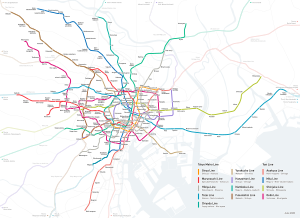Tokyo_subway
Tokyo subway
Part of the rapid transit system in the Greater Tokyo area of Japan
Two rapid transit systems (Japanese: 地下鉄, Hepburn: chikatetsu) operate in Tokyo: Tokyo Metro and the Toei Subway. Most of the network is located in the 23 special wards, with portions extending into Chiba and Saitama Prefectures. The subways are one part of Greater Tokyo's passenger rail network, with through service further connecting the subway to suburban railways in Western Tokyo and Kanagawa Prefecture.
| Tokyo subway | |||
|---|---|---|---|
 | |||
| Overview | |||
| Locale | Tokyo, Japan | ||
| Transit type | Rapid transit | ||
| Number of lines | 13 | ||
| Number of stations | 285 | ||
| Daily ridership | |||
| Annual ridership | 3.921 billion (2019) [3] | ||
| Operation | |||
| Began operation | 30 December 1927 | ||
| Operator(s) | Tokyo Metro Co., Tokyo Metropolitan Bureau of Transportation (Toei) | ||
| Technical | |||
| System length | 304.1 km (189.0 mi) | ||
| Track gauge | 1,067 mm (3 ft 6 in), 1,435 mm for Ginza, Marunouchi, Toei Asakusa & Toei Ōedo Lines, 1,372 mm for Toei Shinjuku Line | ||
| |||
There are two primary subway operators in Tokyo:
- Tokyo Metro – Formerly a statutory corporation called the Teito Rapid Transit Authority (TRTA), it was converted into a kabushiki gaisha (joint-stock company) in 2004. It currently operates 180 stations on nine lines and 195.0 kilometers (121.2 mi) of route.[1]
- Toei Subway – run by the Tokyo Metropolitan Bureau of Transportation, an agency of the Tokyo Metropolitan Government. It operates 106 stations on four lines and 109.0 kilometers (67.7 mi) of route.[4]
As of 2023[update], the combined subway network of the Tokyo and Toei metros comprises 286 stations and 13 lines covering a total system length of 304.0 kilometers (188.9 mi). The Tokyo Metro and Toei networks together carry a combined average of over eight million passengers daily.[5] Despite being ranked second overall in worldwide subway usage (after the Shanghai Metro) as of 2019, subways make up a relatively small fraction of heavy rail rapid transit in Tokyo alone—only 286 out of 938 railway stations, as of 2020.[6] The Tokyo subway at 8.7 million daily passengers only represents 22% of Tokyo's 40 million daily rail passengers (see Transport in Greater Tokyo).[7] Other urban commuter rail systems include Keikyu Corporation (formerly the Keihin Electric Express Railway), Keio Corporation, Keisei Electric Railway, Odakyu Electric Railway, Seibu Railway, Tobu Railway and Tokyu Corporation.
| Line colour | Sign | Line | Japanese | Length | |||||
|---|---|---|---|---|---|---|---|---|---|
| Tokyo Metro | |||||||||
| Orange | Ginza Line | 銀座線 | 14.3 km | ||||||
| Red | Marunouchi Line | 丸ノ内線 | 27.4 km | ||||||
| Marunouchi Line Branch Line | 丸ノ内線分岐線 | 3.2 km | |||||||
| Silver | Hibiya Line | 日比谷線 | 20.3 km | ||||||
| Sky Blue | Tōzai Line | 東西線 | 30.8 km | ||||||
| Green | Chiyoda Line | 千代田線 | 24.0 km | ||||||
| Chiyoda Line Branch Line | 千代田線分岐線 | 2.6 km | |||||||
| Gold | Yūrakuchō Line | 有楽町線 | 28.3 km | ||||||
| Purple | Hanzōmon Line | 半蔵門線 | 16.8 km | ||||||
| Teal | Namboku Line | 南北線 | 21.3 km | ||||||
| Brown | Fukutoshin Line | 副都心線 | 20.2 km | ||||||
| Toei Subway | |||||||||
| Rose | Asakusa Line | 浅草線 | 18.3 km | ||||||
| Blue | Mita Line | 三田線 | 26.5 km | ||||||
| Leaf | Shinjuku Line | 新宿線 | 23.5 km | ||||||
| Magenta | Ōedo Line | 大江戸線 | 40.7 km | ||||||
In addition, but not formally designated as subways:
- The Tokyo Waterfront Area Rapid Transit (TWR) operates a single mostly-underground line with eight stations, and 200,200 daily passengers in 2010.[8]
- The Saitama Rapid Railway Line, which is essentially an extension of the Tokyo Metro Namboku Line, operates a single mostly-underground line with eight stations.
- The Tōyō Rapid Railway Line, which is essentially an extension of the Tokyo Metro Tōzai Line, operates a single underground/elevated line with nine stations.
- The Yamanote Line and Chūō Line (Rapid) are not subway lines, but a surface commuter loop line (Yamanote Line) and a cross-city line that operate with metro-like frequencies. They are owned by JR East, act as key transportation arteries in central Tokyo, and are often marked on Tokyo subway maps.
The Yokohama Subway and the Minatomirai Line also operate in the Greater Tokyo Area, but they are not directly connected to the Tokyo subway network. However, direct through services from the Tokyo Metro Fukutoshin Line regularly run into Yokohama's Minatomirai Line via the Tōkyū Tōyoko Line.
- 1915: Japan's first underground railway opened under Tokyo Station. It was only for the railway post office, not for passengers.[citation needed]
- 1927: Tokyo Underground Railway Co., Ltd. (東京地下鉄道株式会社, Tōkyō Chika Tetsudō Kabushiki Gaisha) opened Japan's first underground line of the subway Ginza Line on 30 December 1927, and publicized as "the first underground railway in the Orient." The distance of the line was only 2.2 km between Ueno and Asakusa.
- 1938: Tokyo Rapid Transit Railway Co., Ltd. (東京高速鉄道株式会社, Tōkyō Kōsoku Tetsudō Kabushiki Gaisha) opened its subway system between Aoyama 6-chome (present-day Omotesando) and Toranomon.
- 1939: Tokyo Rapid Transit Railway extended its line from Toranomon to Shimbashi, and started an reciprocal operation with Tokyo Underground Railway.
- 1941: During World War II, the two subway companies merged under the name Teito Rapid Transit Authority (帝都高速度交通営団, Teito Kōsokudo Kōtsu Eidan) by the local government.
- 1954: The Marunouchi Line, the first subway line after World War II, opened between Ikebukuro and Ochanomizu.
- 1960: Toei Subway Line 1, present-day Toei Asakusa Line, opened between Oshiage and Asakusa.
- 1968: Toei Subway Line 6 (currently the Toei Mita Line) opened between Shimura Station (renamed Takashimadaira Station in 1969) and Sugamo Station.
- 1991: The Tokyo Metro Namboku Line opens.
- 1995: On 20 March, the Tokyo subway sarin attack occurred on the Marunouchi, Hibiya, and Chiyoda Lines during the morning rush hour. Over 5,000 people were injured and 13 people were killed. All three lines ceased operation for the whole day.
- 2000: The Namboku Line opened between Tameike-sanno Station and Meguro Station and the Toei Mita Line opened between Mita Station and Meguro Station, with both lines sharing infrastructure between Meguro Station and Shirokane-takanawa Station. Additionally, both lines started through service with the Tokyu Meguro Line.
- 2004: Teito Rapid Transit Authority was privatized and renamed Tokyo Metro Co., Ltd.
- 2008: The Fukutoshin Line opened.
- 2013: The Fukutoshin Line started through service with the Tokyu Toyoko Line.
- 2023: The Toei Mita Line, the Namboku Line, and the Fukutoshin Line have started through service with the Tōkyū Shin-Yokohama Line, the Sōtetsu Shin-Yokohama Line, the Sotetsu Main Line and the Izumino Line via the Tokyu Meguro Line (Toei Mita Line and Namboku Line) and the Tokyu Toyoko Line (Fukutoshin Line).
Both the Tokyo Metro and Toei Subway systems are closely integrated with a unified system of line colors, line codes, and station numbers. However, the separate administration of metro systems has some ramifications:
- For single rides across Metro and Toei systems, a special transfer ticket is required. It costs 70 yen less than the sum of the Metro fare and the Toei fare, calculated based on the shortest possible route between the origin and destination stations.[9] The Passnet system simplified such ticketing problems, by allowing one stored-fare card to be used on most of the rail operators in the Greater Tokyo Area (with the noticeable exception of JR East which continued to use its own Suica system). The new Pasmo system was introduced in 2007 and completely replaced the Passnet in 2008, finally allowing for one unified stored fare system for most of the Tokyo transit system, including JR East. The fare charged by the stored fare system may be slightly less than for users of paper tickets, as fares are calculated in ¥1 increments on stored fare cards whereas paper tickets are calculated at ¥10 increments.
- The systems represent the metro network differently in station, train, and customer information diagrams. For example, the Toei map represents the Toei Ōedo Line as a circle in the centre, whereas the Tokyo Metro's map saves the central ring line for the Marunouchi Line and the JR Yamanote Line. As well, each system's lines are generally rendered with thicker lines on their respective system maps.
As is common with Japanese subway systems, many above-ground and underground lines in the Greater Tokyo Area operate through services with the Tokyo Metro and Toei lines. Through services operate on all lines except Tokyo Metro Ginza and Marunouchi Lines and Toei Oedo Line. In a broader sense they are considered a part of the Tokyo subway network, allowing it to reach farther out into the suburbs.
Tokyo Metro
Toei Subway
| Line | Through lines | |
|---|---|---|
| A | Asakusa Line | Keikyu Kurihama Line and Keikyu Airport Line both via the Keikyu Main Line (Sengakuji to Haneda Airport (Tokyo International Airport) or Misakiguchi) |
| Keisei Oshiage Line, Keisei Main Line, Hokuso Railway Line, Keisei Higashi-Narita Line and Shibayama Railway Line (Oshiage to Narita Airport, Inba-Nihon-Idai or Shibayama-Chiyoda) | ||
| I | Mita Line | Tokyu Meguro Line (Meguro to Hiyoshi) |
| S | Shinjuku Line | Keio New Line and Keio Sagamihara Line both via the Keiō Line (Shinjuku to Hashimoto or Takaosanguchi) |
- "Business Situation". Tokyo Metro. 27 June 2023. Retrieved 25 August 2023.
- "TOP>Service>What is Toei Subway?". Tokyo Metropolitan Bureau of Transportation. Retrieved 24 February 2021.
- "Subways keep Tokyo on the move". Japan Today. Archived from the original on 22 October 2007. Retrieved 24 January 2007.
- "【2020年版】緯度経度付き全国沿線別駅データ" (in Japanese). Retrieved 24 February 2021.
- 平成17年 大都市交通センサス 第10回 [2005 Metropolitan transportation census (10th)] (PDF) (in Japanese). 国土交通省 総合政策局 交通計画課 [Land, Infrastructure and Transportation Ministry, Transport Policy Bureau]. 30 March 2007. Retrieved 17 January 2016.
- "企業・採用|お台場電車 りんかい線" (PDF).
- Tokyo Metropolitan Bureau of Transportation. "Toei Subway Information - How to Ride the Subway". Archived from the original on 27 March 2010. Retrieved 25 June 2008.
- Gibson, William (1999). All Tomorrow's Parties. New York: G.P. Putnam's Sons. ISBN 0-399-14579-6.
- Wolf, Michael (2010). Tokyo Compression. Hong Kong & Berlin: Asia One Books & Peperoni Books. ISBN 978-3-941825-08-6.


